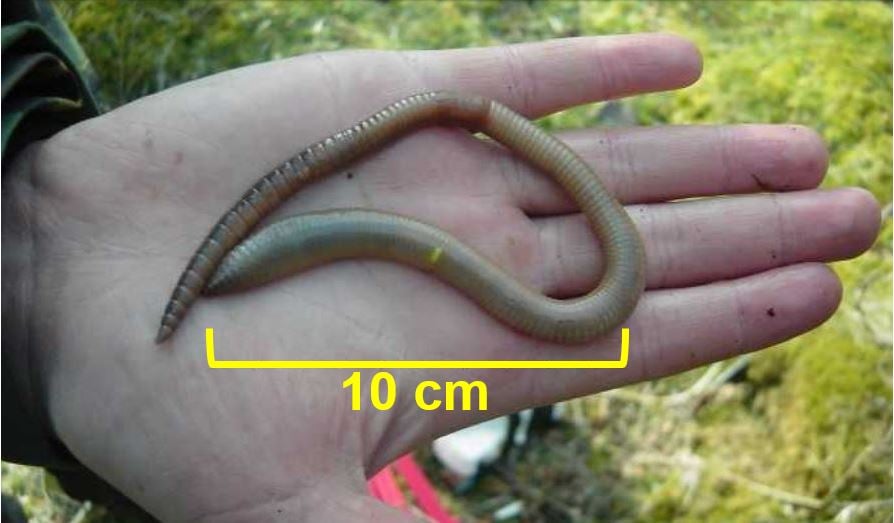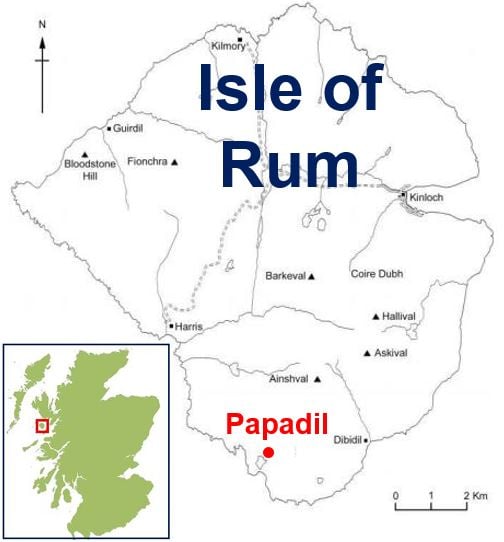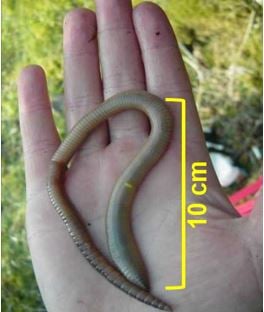Scientists found mega earthworms the size of small snakes in the Isle of Rum, one of the small isles of the Inner Hebrides. They are the largest worms ever seen in the United Kingdom – about three times the size and weight of an average worm; the equivalent in the human world of finding a village full of 17-foot-tall men.
Dr. Kevin Butt, Reader in Ecology and Research Coordinator, School of Forensic and Applied Sciences at the University of Central Lancashire, says these remarkably huge invertebrates can reach 1.3 feet (40 cm) in length, thanks to the rich soil of the island and very few animals that eat them.
Dr. Butt, lead scientist of the Earthworm Research Group at the University of Central Lancashire, was interviewed by presenter John Humphrys on the BBC Radio 4 Today programme.
 Mega earthworm (dew worm) from Papadil with a visible yellow tag just before it was released. The researchers periodically returned over a period of six years to monitor the worms. (Image: glasgownaturalhistory.org.uk)
Mega earthworm (dew worm) from Papadil with a visible yellow tag just before it was released. The researchers periodically returned over a period of six years to monitor the worms. (Image: glasgownaturalhistory.org.uk)
Triple the weight of a normal earthworm
Dr. Butt said:
“These things weigh about twelve and a half grams – but the normal size for these things is about four to five grams.”
Dr. Butt and colleagues wrote about their study and findings in The Glasgow Naturalist journal (Citation and link below).
In an Abstract in the journal, the authors wrote:
“Exceptionally large (>12 g live mass) individuals were found in soils of terraces on wooded slopes, suggesting that dew worms may be long lived at this location, where food is abundant and relatively few terrestrial predators are present.”
Dr. Butt agreed with Mr. Humphrys’ comment that the whole thing was ‘slightly spooky’. The reddish worms (Lumbricus terrestris) were discovered at Papadil, a tiny deserted settlement with a population of about thirty inhabitants, and one of the few locations on Rum where a naturally developed brown earth soil is present.
When the researchers first saw the goliath worms coming out of their burrows, they were like little snakes, Dr. Butt said.
 The giant earthworms were found in Papadil in the Isle of Rum. (Image: glasgownaturalhistory.org.uk)
The giant earthworms were found in Papadil in the Isle of Rum. (Image: glasgownaturalhistory.org.uk)
In an interview with the Telegraph, Dr Butt said the existence of such worms are far from being the stuff of nightmares – rather a ‘delight’ to discover, because they play such an important role in the ecosystem, and help reduce the risk of flooding.
Earthworms vital for the ecosystem
They are as important as bees are in pollinating plants “Without their activities we would be a lot worse off,” he explained. Worms help aerate the soil and drain away water. They also stop surface erosion.
The worms’ mega length and weight are due mainly to the island’s remote and undisturbed location, as well as Papadil’s excellent-quality soil.
There are no foxes, hedgehogs, moles, or badgers – all worm eating creatures – in Rum. If they were present, the worms would have been gobbled up before they had a chance to get too big.
Earthworms just carry on growing
Earthworms are different in one particular way from humans and nearly all other animals. We grow and reach a certain size, regardless of whether there are predators about or how much food we eat. Earthworms just carry on growing if you give them the chance.
Dr. Butt, an earthworm expert who has been studying them for over thirty years, explained:
“These things have just have been left and have grown bigger and bigger.”
Dr. Butt was asked whether these worms would grow to giant sizes if a schoolchild looked after one and gave it the right soil and environment. He said he could not see why not.
Dr. Butt said:
“In the laboratory we can keep them and feed them well and in a matter of a couple of years you can grow them to 15, even 20 grams.”
There is nothing to fear from earthworms, he emphasized. When they hear your footsteps they simply go down deeper into the earth – there is no chance they’ll jump out and attack you.
Citation: “An Oasis of Fertility on a Barren Island: Earthworms at Papadil, Isle of Rum,” K. R. Butt, C. N. Lowe, M. A. Callaham Jr. and 3V. Nuutinen. The Glasgow Naturalist. 6 January, 2016.
Audio Recording – Dr. Butt talking to John Humphrys


Comments are closed.